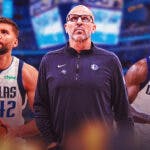The Nets franchise moved to Brooklyn in 2012, and, one year later, orchestrated of the most disastrous trades in NBA history: acquiring Kevin Garnett, Paul Pierce, and Jason Terry—all in their late 30's—from the Boston Celtics for a package of contracts and four(!) future first-round picks. Two of those picks turned into Jaylen Brown and Jayson Tatum, while one was used to acquire Kyrie Irving from the Cleveland Cavaliers (yes, he’s on the Nets now—but still).
In then–general manager Billy King’s defense, he was under pressure to build an immediate contender from a brash new owner, Russian billionaire Mikhail Prokhorov. In the half-decade since Prokhorov stepped aside (he eventually sold the team in 2017), the Nets organization has operated far more intelligently, led by the shrewd management of GM Sean Marks.
In the spirit of where the franchise stands today—in the playoffs with a slew of solid young-ish players and two superstars in waiting—let’s revisit the best trades in Nets history.
5. Caris LeVert for Thaddeus Young (2016)
After the crippling Boston trade, with the team bottoming out and stuck in cap hell, Marks masterfully rebuilt the organization by focusing on player development and conducting a series of creative acquisitions.
Perhaps his best trade came on draft day, 2016, when he flipped Thaddeus Young for the pick that would become Caris LeVert. Young was a quality veteran starter, but LeVert has blossomed into a future All-Star—and has particularly shined in the bubble.
At 25, in his third season, the versatile wing has averaged 18.7 points per game in 45 games, and 25.0 points per game in the restart. He’s also displayed a knack for setting up his teammates in recent games, upping his assists per game to 6.7 while carrying a shorthanded Nets squad in Orlando.
If he can stay healthy, the future is extremely bright for LeVert.
4. Vince Carter (2004)
Nets fans (of which I was one) were disappointed when the team let Kenyon Martin sign with the Denver Nuggets in the summer of 2004, but the front office partially made up for it by acquiring Carter early into the 2004-05 season.
Carter had grown disgruntled (to put it mildly) in Toronto, and his diminishing effort lowered his trade value. New Jersey pounced; dumping veteran salaries, like Alonzo Mourning, on Toronto along with two picks that resulted in Joey Graham in 2005 (No. 16 overall) and Renaldo Balkman in 2006 (used by the New York Knicks).
Carter didn’t quite elevate the Nets into title contenders—they never advanced past the second round with Vinsanity—but they did make the postseason three times in his four-plus seasons.
Carter’s points per game average on the Nets, 23.6, ranks first in franchise history (post-ABA), and he played in three All-Star games in Nets uniform.
In tandem with Jason Kidd (and some Richard Jefferson), the mid-aughts Nets produced an electrifying reel of highlights.
3. Richard Jefferson and Jason Collins (2001)
During the 2001 draft, Hall of Fame executive Rod Thorn, named GM of the Nets in 2000, shipped Eddie Griffin (No. 7 overall) to the Houston Rockets for the No. 13 (Jefferson), No. 18 (Collins), and No. 23 picks (Armstrong).
Griffin was a prized prospect, but he never met the expectations in an underwhelming career. Richard Jefferson and Jason Collins, both coming off four years at Pac-10 schools, became long-term starters and key players on New Jersey’s back-to-back Finals teams of 2002 and 2003.
In seven seasons in New Jersey, Jefferson averaged 17.4 points per game, while Collins, an elite interior defender, started 405 games (and 58 playoff games) as a Net.
2. Julius Erving (1973)
The cash-strapped Virginia Squires let Julius Erving go to the Nets, who signed an eight-year deal for $350,000 annually.
In New York (well, Long Island), Dr. J rapidly became the face of the ABA. In 1973-74, he averaged 27.4 points and 10.7 rebounds, winning MVP honors for the regular season and playoffs. In 1976, he produced the first memorable dunk contest moment with his free-throw line flight in those classic Nets unis, then led the Nets to another title later that season.
Erving spent just three years in New York, though, as he joined the Sixers after the 1976 ABA-NBA merger.
He averaged 28.2 points (50.8 percent from the floor) and 10.9 rebounds per game in his Nets career, and he remains arguably the most iconic player in Nets history. His No. 32 is retired by the franchise.
1. Jason Kidd for Stephon Marbury
Stephon Marbury was a supremely talented All-Star player who was never able to lead a winning team, while Jason Kidd possessed an innate ability to make his teammates better with his Hall of Fame point guard skills.
Kidd ushered one of the biggest turnarounds in league history, leading the Nets to 52 wins in his first year in the Meadowlands—an 26-win improvement from 2000-01. He finished second in the MVP voting, averaging 16.9 points, 10.8 assists, and 6.8 rebounds per game.
Kidd led the Nets to consecutive Finals and was possibly on his way to a third before injuring his knee in the 2004 Eastern Conference Finals against the eventual-champion Detroit Pistons.
In his six-plus seasons in New Jersey, Kidd made five All-Star teams and averaged 14.6 points, 9.1 assists, and 7.2 rebounds per game. In 78 playoff appearances, he was even better: 16.8 points, 9.1 assists, and 8.2 rebounds per game.
Kidd is undoubtedly the greatest Nets player (post-ABA), and his No. 5 is retired by the franchise. Kidd was inducted into the Naismith Memorial Basketball Hall of Fame in 2018.




